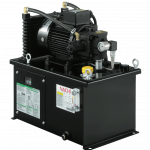How Do Hydraulic Systems Work?
Hydraulic Systems are everywhere. They make our lives a lot easier, but many people don’t know how they work. To them, hydraulics are a black box, the invisible workings behind everyday items.
But hydraulic systems aren’t magic, and understanding them can make working with them easier. So, here is hydraulics 101—the basics explained simply.
Pascal’s Law
Hydraulics are based on a law of physics discovered in the 1600’s by a man named Blaise Pascal. An article from NASA summarized the law as, “when there is an increase in pressure at any point in a confined fluid, there is an equal increase at every other point in the container.
Essentially, if you have a bottle filled with water (a fluid) and you press on the cork (which has an area of one inch) with one pound of force, then you’re putting the liquid under one PSI (pounds per square inch) of pressure. Because of this, the liquid exerts one PSI of pressure equally on all the walls of the bottle.
Bright Hub Engineering gives the example of a tube of toothpaste. Imagine you have a tube of toothpaste with the cap on and a bunch of holes poked in the sides. When you press on the tube, an equal amount of toothpaste will come out each hole. The fluid (the toothpaste) is carrying the force from your finger and pressing outward in all directions equally.
Multiplication of Force
Not only can hydraulic fluid carry force, but it can also multiply force.
Imagine you have two pistons connected by hydraulic fluid. One piston has one inch of surface area, and the other has 10 inches. Now, if you press down on the smaller piston with one pound of force, you’ll create one PSI of pressure on the liquid, and the liquid will press on the larger piston with one PSI of pressure.
Here’s the catch, however. Since the larger piston has a surface area of 10 inches, it will experience 10 pounds of force upwards (one PSI of pressure times 10 inches of surface area equals 10 pounds of force).
You apply one pound of force to one piston and get ten pounds of force on the other, thus multiplying the force.
Shop for Hydraulics Online
Law of the Conservation of Energy
This may seem strange. How can you put a small amount of force in and get a larger amount back? That’s like putting $50 into the bank and getting $500 back. It seems to contradict the Law of the Conservation of Energy.
The reason this works, however, is because we’re multiplying force not energy. And while we’re getting more force back than we put in, there is a tradeoff.
Energy cannot be created or destroyed, and energy is equal to force times distance. So, if force is increasing, but energy is staying the same, then distance must be decreasing.
Back to the example: If you press the small piston 10 inches downward, the larger piston will rise one inch. Force is being multiplied but distance is being divided, and the two cancel each other out so that energy remains the same.
You could press down with one pound of force on a piston and move a school bus, but you’ll have to press the piston down very far and the bus is only going to move a minuscule amount.
All hydraulic systems are built on these two simple principles: transfer of energy and multiplication of force. Of course, these systems can also get very complex with many moving parts.
Want to learn how to read a hydraulic schematic? Click here.
Hydraulics vs. Pneumatics
Hydraulics use liquids like oil while pneumatics use air. Because air is compressible, but hydraulic oil isn’t, hydraulics are more exact. Pneumatic systems, however, are much simpler. Which one works best depends on the situation.
As Thomasnet.com (a technology company) summarizes it, “Most differences between these two systems stem from the fact that hydraulic systems use liquids, which do not compress, and pneumatic systems use gasses, which do. These affect the way the systems function and are built, as well as their capabilities and applications in the field. In a nutshell, hydraulic systems are bigger and slower, but provide higher precision and more power, whereas pneumatic systems are better suited for applications requiring quicker, more compact systems with lesser force and precision.”
Do you need hydraulic or pneumatic equipment for your business? We’ll design custom systems to fit your needs. AHE also has highly trained employees who can help you.










